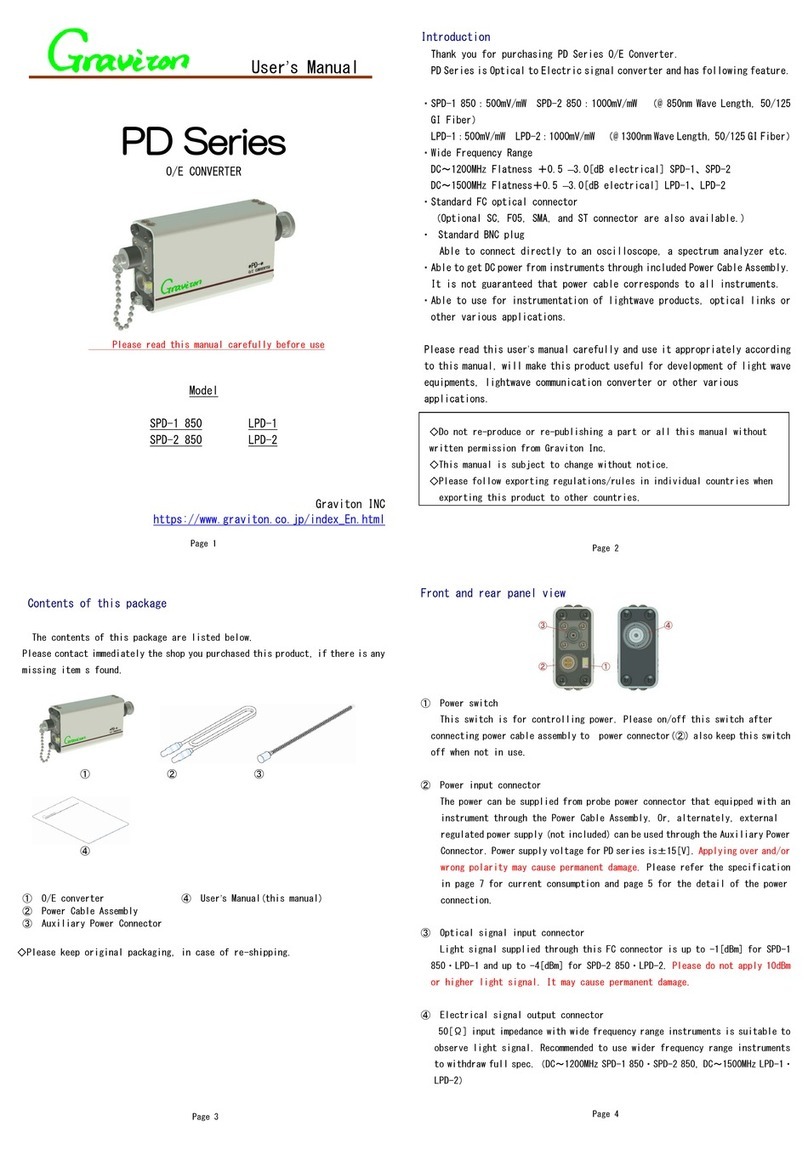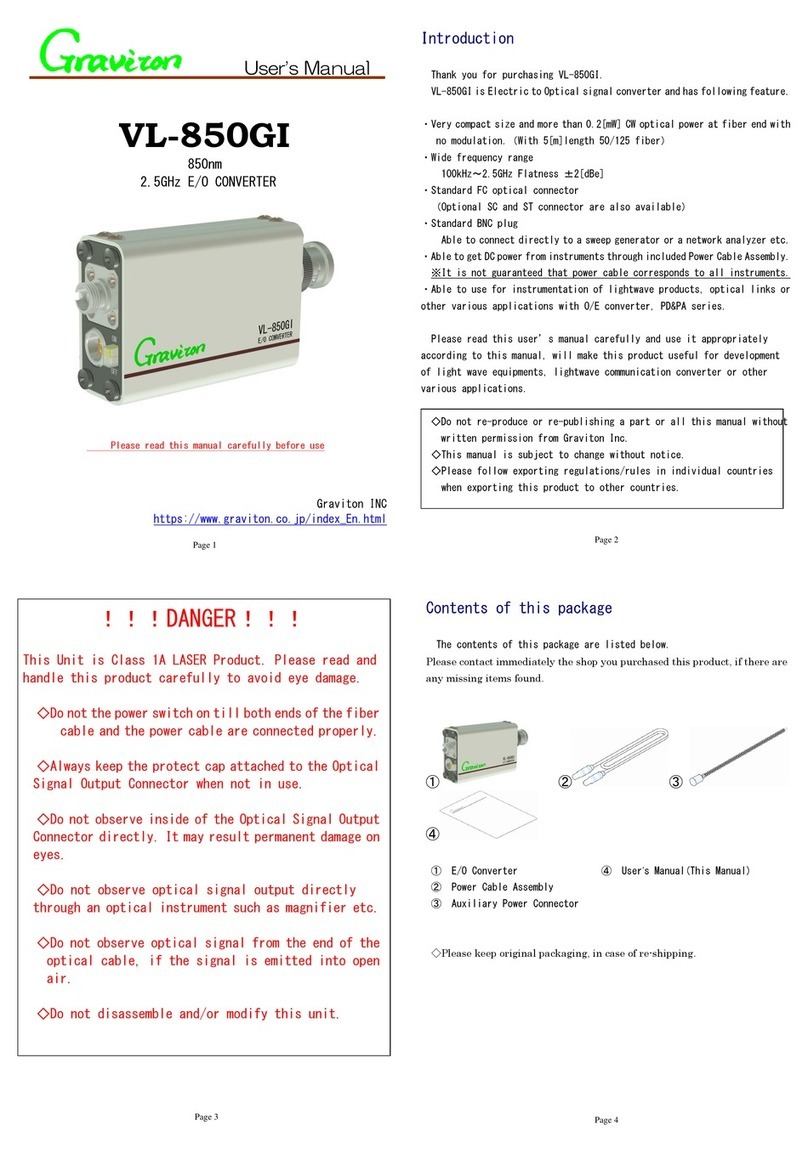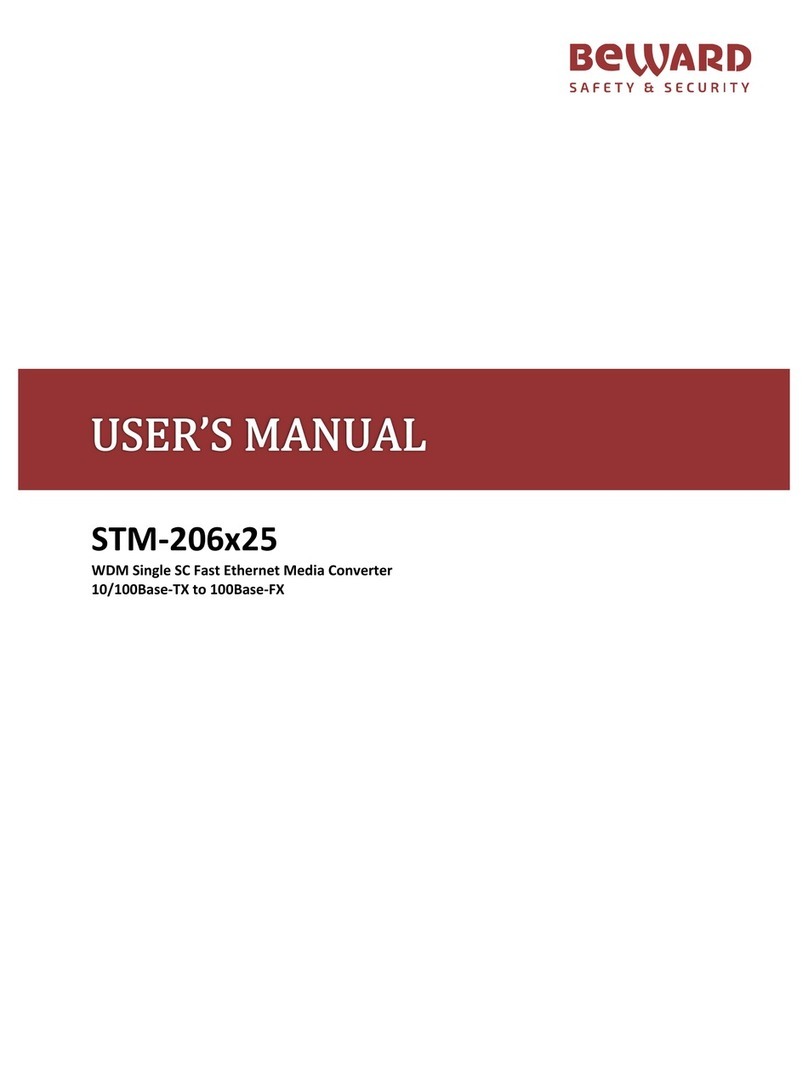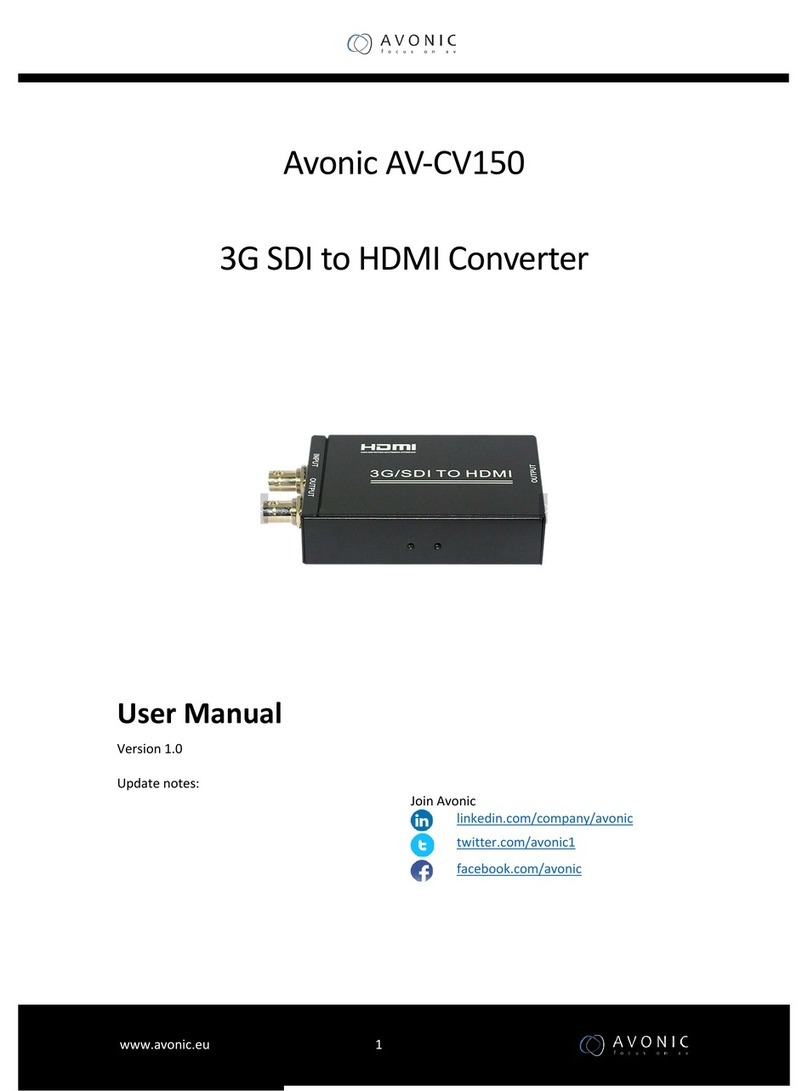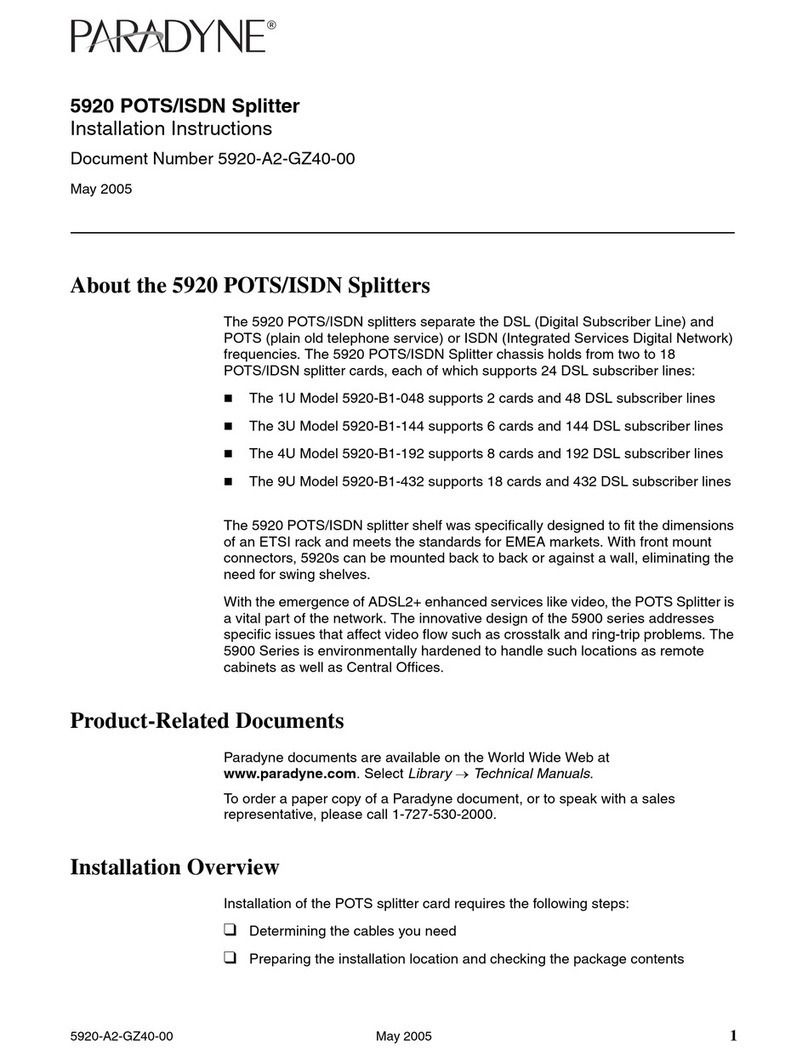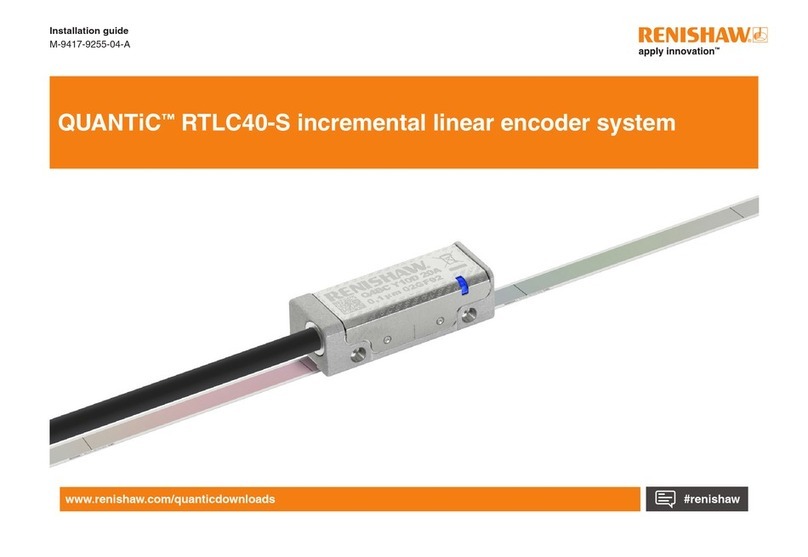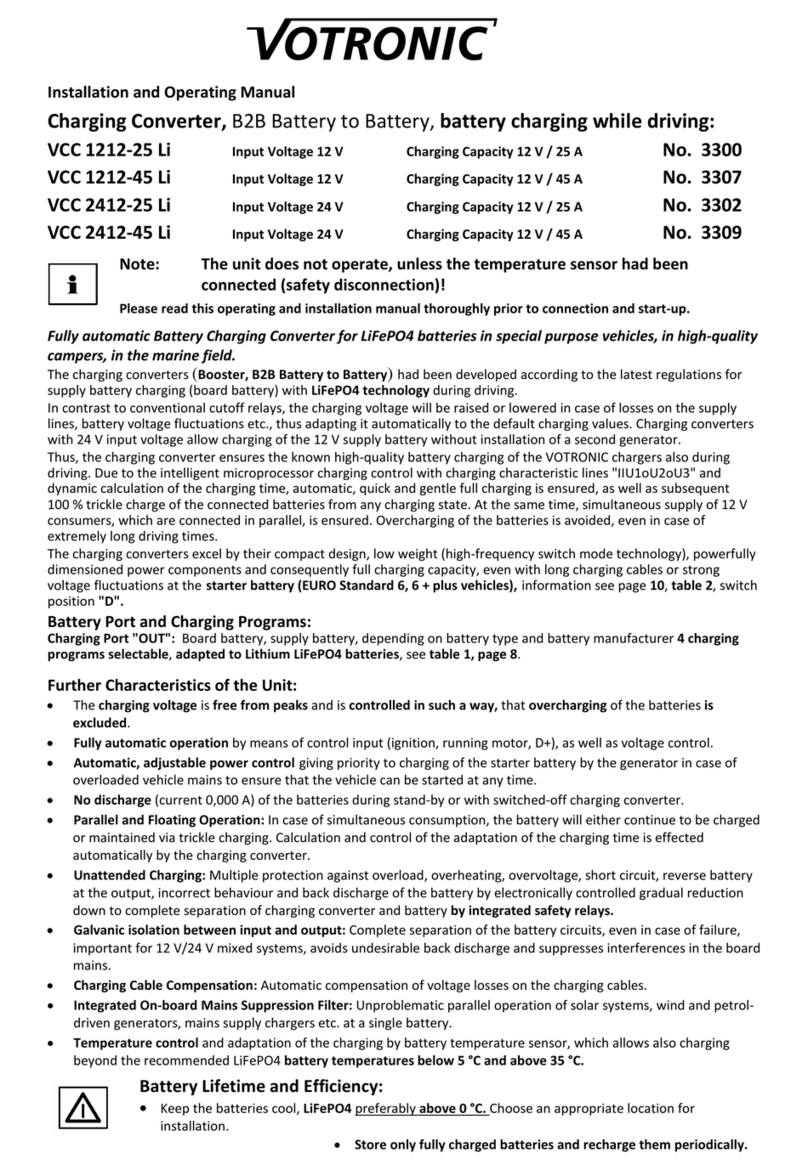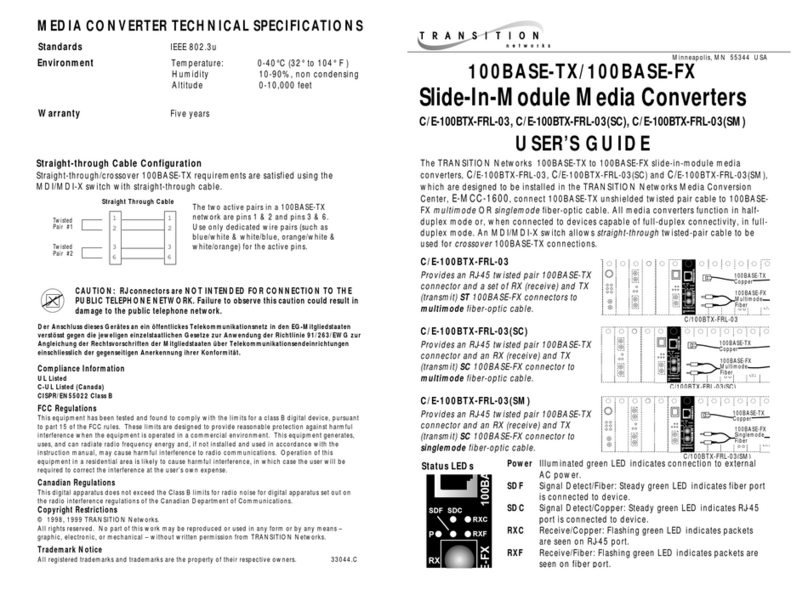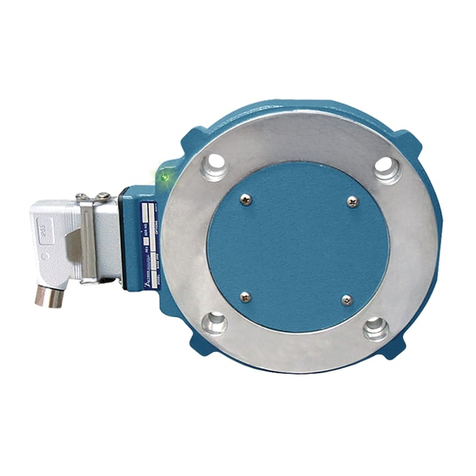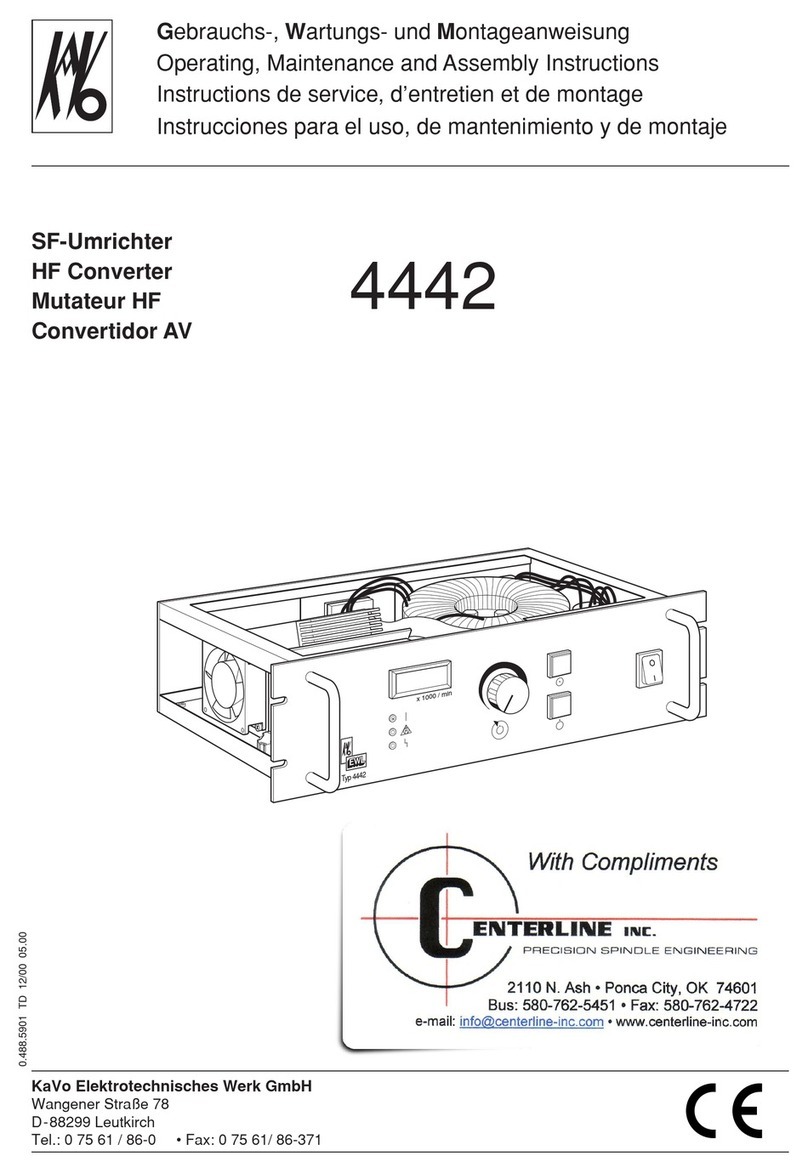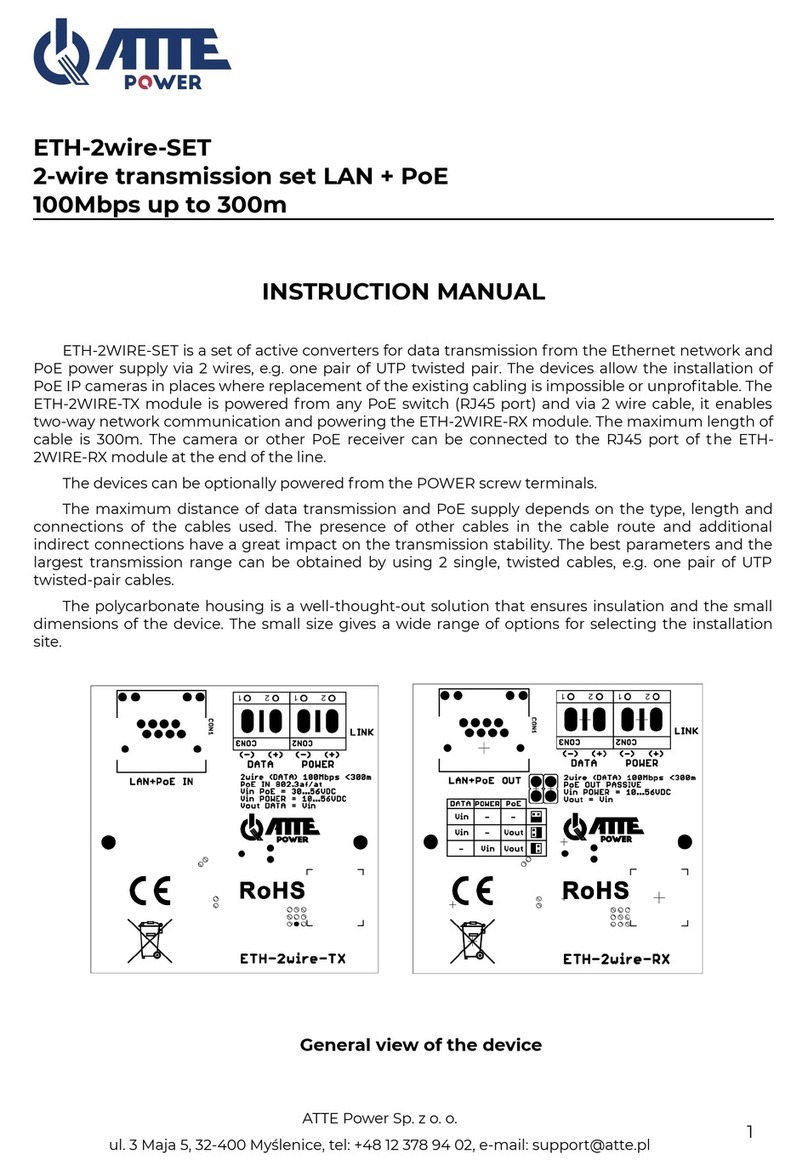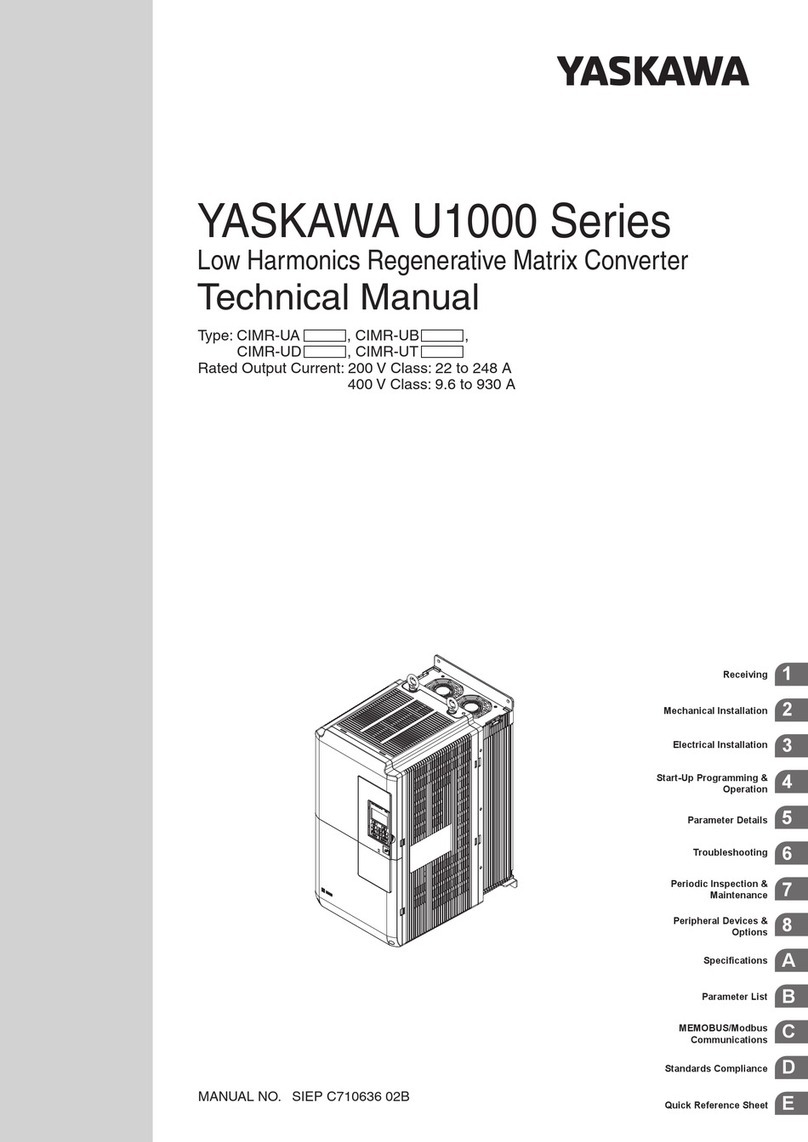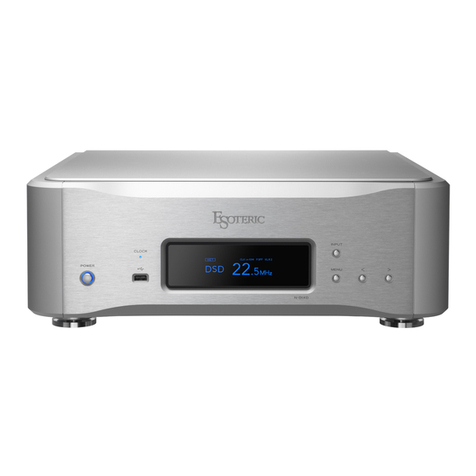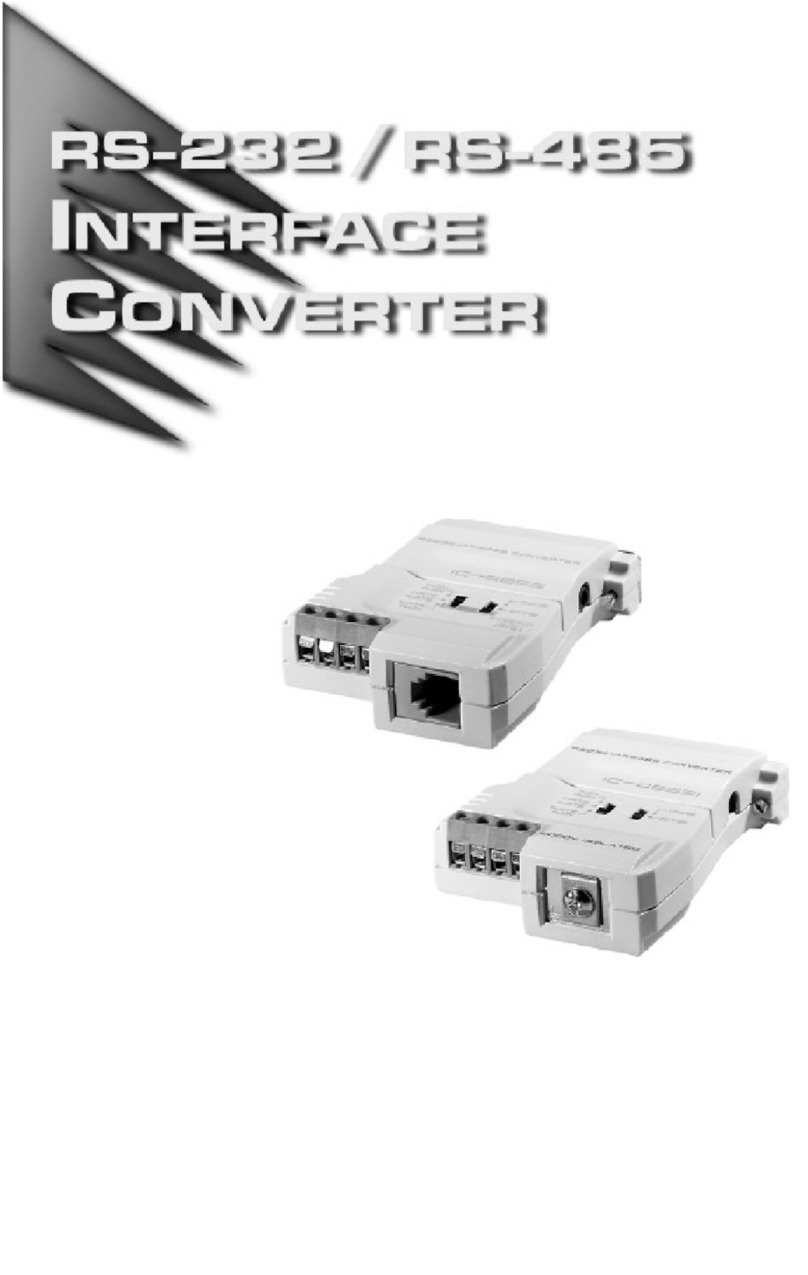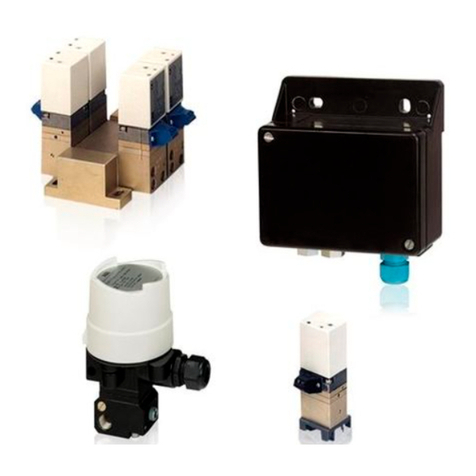Graviton SPD-1_650nm User manual

-- Links to each page --
* Overview
* Precautions
* Contents of the package
* Part names and functions
* Mount and connection
* Shipment data and
measurement examples
* Comparison of the lens
system
* Comparison of the step
responses
* Comparison of the frequency
characteristics
* Comparison of the spectral
sensitivity
* Frequency characteristic
dependence on the wavelength
* Specifications for each model
* Options and accessories
* Calibration and Export
certificates
* Contact information
Overview
Graviton's O/E converter allows the measurement of the
optical signal, by attaching to the input terminal of the
customer's measurement equipment.
* Small size, light weight, easy to attach
* Large detection diameter and NA
* Covers wide band from DC to GHz
* Many types of optical connector option
Read this instruction manual carefully before use.
Selection guide
Graviton offers a variety of O/E converter models, by the requested features of; Wavelength range, Reference
wavelength, Acceptable core diameter, Input NA, and Conversion frequency bandwidth.
* Converter for visible light (Si photodetector is used)
Model name Wavelength range Reference
wavelength Sensitivity Max. core
diameter Max.NA Bandwidth tr/tf
SPD-1_650nm 320nm〜1000nm 650nm 500V/W 0.8mm 0.2 DC〜1.2GHz 290ps
SPD-1_850nm 320nm〜1000nm 850nm 500V/W 0.8mm 0.2 DC〜1.2GHz 290ps
SPD-2_650nm 380nm〜1000nm 650nm 1000V/W 1.0mm 0.25 DC〜1.2GHz 290ps
SPD-2_850nm 380nm〜1000nm 850nm 1000V/W 1.0mm 0.25 DC〜1.2GHz 290ps
SPD-3 380nm〜950nm 850nm 500V/W 0.5mm 0.25 DC〜2.0GHz 190ps
SPD-4 380nm〜950nm 850nm 300V/W 0.5mm 0.25 DC〜3.0GHz 150ps
SPA-2_650nm 400nm〜1000nm 650nm 1000V/W 1.0mm 0.5 DC〜1.0GHz 370ps
SPA-3 380nm〜950nm 850nm 500V/W 0.25mm 0.5 DC〜2.0GHz 190ps
SPA-4 380nm〜950nm 850nm 300V/W 0.25mm 0.5 DC〜3.0GHz 150ps
SPS-1_10KV/W 320nm〜1000nm 850nm 10KV/W 0.8mm 0.2 DC〜100MHz 3.6ns
SPS-1 100KV/W 320nm〜1000nm 850nm 100KV/W 0.8mm 0.2 DC〜15MHz 28ns
SPS-2_10KV/W 400nm〜1000nm 850nm 10KV/W 1.0mm 0.5 DC〜100MHz 3.6ns
SPS-S_100KV/W 400nm〜1000nm 850nm 100KV/W 1.0mm 0.5 DC〜15MHz 28ns
* Converter for long wavelength (InGaAs photodetector is used)
Model name Wavelength range Reference
wavelength Sensitivity Max core
diameter Max.NA Bandwidth tr/tf
LPD-1 900nm〜1650nm 1310nm 500V/W 0.08mm 0.2 DC〜1.5GHz 250ps
LPD-2 950nm〜1650nm 1310nm 1000V/W 0.5mm 0.25 DC〜1.5GHz 250ps
LPS-1_20KV/W 900nm〜1650nm 1310nm 20KV/W 0.08mm 0.2 DC〜100MHz 3.5ns
LPS-2_20KV/W 950nm〜1650nm 1310nm 20KV/W 0.5mm 0.25 DC〜100MHz 3.5ns
Instruction manual of O/E converter - Overview

** For 650nm standard model and 850nm standard model **
Photodetector, which is currently build in SPD-1, SPD-2, and SPA-2, has the wavelength dependency of a
frequency characteristic, and the frequency characteristic of photodetector changes in the range of, approximately, 1MHz
to 100MHz.
Therefore, a frequency characteristic of SPD-1_650nm, SPD-2_650nm, and SPA-2_650nm, is designed and tuned to be
flat at 650 nm. Also, the frequency characteristic of SPD-1_850nm and for SPD-2_850nm is designed to be flat at 850 nm.
For customers who need several wavelengths measurements, it is recommend the use of SPD-3, SPD-4, SPA-3, SPA-4
with PD which has less frequency characteristic dependence on the wavelength.
** About the minimum fiber diameter **
The core diameter of the fiber, to be connected to the SPA-2_650nm, is 100um diameter or more. When a fiber with a
thin fiber core diameter is used, the optical spot at the photodetector becomes so small, that the frequency characteristics of
the product is not maintained.

-- Links to each page --
* Overview
* Precautions
* Contents of the package
* Part names and functions
* Mount and connection
* Shipment data and
measurement examples
* Comparison of the lens
system
* Comparison of the step
responses
* Comparison of the frequency
characteristics
* Comparison of the spectral
sensitivity
* Frequency characteristic
dependence on the wavelength
* Specifications for each model
* Options and accessories
* Calibration and Export
certificates
* Contact information
Precautions
* DANGER: Avoid water, liquid or the wet
When the product gets wet, this may cause irreparable damage to the internal optical system or
electronic circuit. In addition , it may cause a fire when the power is supplied to the wetted product.
Avoid the wet, absolutely.
* DANGER: No wet hand(s)
If the equipment is touched by wet hands , it may not only to cause a malfunction to the product, but
to cause an electric shock on human body. Avoid the wet, absolutely.
* DO NOT disassemble
Some part of the O/E converter is designed and engineered with high-precision. If the product is
disassembled, it may cause spoiling a performance of the product.
* CAUTIONS when attaching or detaching a connector
When an optical connector or a power cord is detached or attached, be sure to perform attachment or
detachment by holding plug with hands. Avoid to pull a power cord or a fiber optic cable.
* NOT TO APPLY the external force to the unit.
Take caution not to apply external force to the unit, attached to such as test equipment or measurement
instrument, optical fiber cord ,or power cord. It may cause damage to the converter, an electronic
measuring instrument, or a code.
* CAUTIONS for a laser beam
When using a laser beam, take enough precautions for the safety of the eyes and skin. Do not view the
beam directly.
Instruction manual of O/E converter - Precautions

-- Links to each page --
* Overview
* Precautions
* Contents of the package
* Part names and functions
* Mount and connection
* Shipment data and
measurement examples
* Comparison of the lens
system
* Comparison of the step
responses
* Comparison of the frequency
characteristics
* Comparison of the spectral
sensitivity
* Frequency characteristic
dependence on the wavelength
* Specifications for each model
* Options and accessories
* Calibration and Export
certificates
* Contact information
Contents of the package
** As soon as opening a package, first check all items are present in the package.
** In the event where any items are missing or damaged , please contact us immediately.
* O/E converter unit
Instruction manual of O/E converter - Contents of the package

* Dedicated power cable
Dedicated power cable for supplying DC power to the O/
E converter.
The plug is LEMO 0S 4P type, and the pin assignments
of the connector are P1:OPEN, P2:GND, P3:-15V, and
P4:+15V.
Some electronic instruments, to be used at the same time,
are equipped with a power supply connector that can be
connected to this connector.
* Auxiliary power cable
When the customer does not equip with a power supply,
that can be connected directly to the converter using the
dedicated power cable, use the auxiliary power cable in
order to connect the O/E converter and the DC power
supply.
In addition, Graviton offers a small-sized DC power
supply, suitable for our O/E converter products.
* USB memory
The characteristics of the Graviton's O/E converter is
measured individually at the time of shipment, and the
result is written on the USB memory. This USB memory
is included in the product. Calibration and repair history
are also stored on this USB memory.
Moreover, a user's manual of the product and a catalog
are stored on this USB memory.
* Wooden box
Stores the product and accessories.

-- Links to each page --
* Overview
* Precautions
* Contents of the package
* Part names and functions
* Mount and connection
* Shipment data and
measurement examples
* Comparison of the lens
system
* Comparison of the step
responses
* Comparison of the frequency
characteristics
* Comparison of the spectral
sensitivity
* Frequency characteristic
dependence on the wavelength
* Specifications for each model
* Options and accessories
* Calibration and Export
certificates
* Contact information
Part names and functions
[1] Optical input connector
Inputs an optical signal for the measurement to the O/E
converter. A standard product is equipped with
receptacle of FC type, however, a product, equipped
with other type of optical connector is available when
the customer specifies an option when ordering..
[2] DC power input connector
Supplies required DC power voltage for the O/E
converter from this connector.
[3] Power switch
[4] Dust cap
The product with FC receptacle has duct-cap to prevent
a dust, which go into the optical input connector.
[5] Electrical output connector
After the O/E conversion is performed, a voltage signal
is outputted from this connector. This connector also
has a feature which secures the unit to an input terminal
of electronic measuring instrument.
The standard product is equipped with the BNC type
plug, as shown in the figure. A product, equipped with
other types, such as SMA, of electric output connector
is available upon customer's optional specification when
ordering..
Instruction manual of O/E converter - Part names and functions

* Pin assignment of a DC power connector
[P1] : OPEN
This pin is not connected internally.
[P2] : GND pin
This pin is connected to the chassis internally.
[P3] : Minus 15V input pin
Minus 15V power source of a product is supplied from
this pin.
** However, since the negative supply voltage for SPA-
2_650nm is not used, this pin is not connected
internally.
[P4] : Puls 15V input pin
Plus 15V power supply to the product is supplied from
this pin.

-- Links to each page --
* Overview
* Precautions
* Contents of the package
* Part names and functions
* Mount and connection
* Shipment data and
measurement examples
* Comparison of the lens
system
* Comparison of the step
responses
* Comparison of the frequency
characteristics
* Comparison of the spectral
sensitivity
* Frequency characteristic
dependence on the wavelength
* Specifications for each model
* Options and accessories
* Calibration and Export
certificates
* Contact information
Mount and connection
[1] Attach the O/E converter to an electronic measuring instrument.
Since O/E converter is designed with small size and light weight, the converter can be attached and fixed by connecting
directly to the input connector of the measuring instruments, as shown in the figure.
The measuring instrument, shown, is equipped with BNC jack. How to connect directly to the O/E converter of
standard type, equipped with BNC plug is shown. When an input connector of an electronic measuring instrument does
NOT have a BNC jack, use a off-the-shelf coaxial adapter in order for the instrument to fit with O/E converter.
[2] Connect the power cable.
Plug a dedicated power cable into the power input connector of the O/E converter. Insert the power cable when the
power switch [3] is at the OFF position. Further, it is desirable to supply the power from the external power supply
after the power cable has been connected.
[3] Turn the power switch ON.
[4] Insert a optical signal line to the connector.
Insert and secure the optical connector ferrule of an optical signal line to be measured to the optical input connector of
the O/E converter. The O/E converter of standard model has equipped the panel with the FC type receptacle. The figure
shows how to insert FC type optical connector plug.
If a connector other than the FC type is equipped with the customer's instrument, either use an off-the-shell connector-
adapter, or specify the connector option when the customer places an order of an O/E converter. Currently, the products
for SC connector, (F) SMA connector, ST connector, and F05 connector are available.
Instruction manual of O/E converter - Mount and connection

In addition, when a diameter of the customer's connector ferrule is 2.5mm, a product with G-OCN type connector,
which is connectable to any type, is available. Please contact us about G-OCN-type related information.
* Auxiliary power cable
Some of the electronic instruments, used together with the O/E converter, does not have a DC power supply output
connector that can be fitted to the dedicated power cable. In such a case , using the auxiliary power cable, supply ± 15V
DC power to O/E converter from such as the external off-the-shell power supply.
** Graviton has Cosel's power supply - G1W-15 in stock.
[1] Connect an auxiliary power cable to the external power supply.
After checking the output of the power supply is off, connect the power supply and auxiliary power cable. Connect the
RED wire of auxiliary power cable to +15V, the BLACK wire to GND, and the BLUE wire to -15V.
The faulty wiring of a power supply cable causes failure to the O/E converter. Work carefully so as not to make
connection mistake.
[2] Connect a dedicated power cable and an auxiliary power cable.
[3] Plug in a dedicated power cable to the power connector of the O/E converter.
Before the power cable will be connected to the O/E converter, check that the power switch, shown in [4], is OFF.
[4] Turn ON the power supply unit and turn the switch of an O/E converter.
As an order of powering on, turn on the power supply, the first. As an order of powering off, the order of power off
does not matter.

To fix an auxiliary power cable to the panel,
a cutout hole dimension is an oblong hole 9.2
mm in diameter, and 8.4 mm in width, as
shown on the left figure.
In addition, use panel with 5mm thick or less.

-- Links to each page --
* Overview
* Precautions
* Contents of the package
* Part names and functions
* Mount and connection
* Shipment data and
measurement examples
* Comparison of the lens
system
* Comparison of the step
responses
* Comparison of the frequency
characteristics
* Comparison of the spectral
sensitivity
* Frequency characteristic
dependence on the wavelength
* Specifications for each model
* Options and accessories
* Calibration and Export
certificates
* Contact information
Pre-shipment test and waveform data
Actual measurement data file, that have been performed individually one at a time, is included in the product;
Graviton's O/E converter. By using an example of SPD-2_650nm, the waveform data will be explained.
* Impulse response (Green)
Regarding the pre-shipment test of the O/E
converter, an impulse response waveform, a
step response waveform, and a frequency
characteristic are measured by inputting an
impulse light with duration of about 50ps to
the converter.
Among the waveforms shown in the figure on
the left, what is drawn in green color shows the
impulse response of the O/E converter.
The numerical value of "+width (2)" indicates
278.6ps, and this value is found as the impulse
output half width out of an O/E converter
output.
* Step response (Yellow)
Simulates the output waveform when the
optical step pattern waveform is inputted to the
O/E converter, using a feature of the
oscilloscope, and applying the integration for
the impulse response waveform.
The value of "Rise time (f1)" indicates as
273.3ps, and this means that the step response
speed is within 10% to 90% of the O/E
converter. In addition , the value of the
overshoot can be seen as 1.60 percent.
* Frequency characteristic (Purple)
By performing the FFT computation, which is
a feature of the oscilloscope, to the impulse
response waveform, the frequency
characteristics of the O/E converter is
measured.
The horizontal axis scale is 500MHz/div., and
the vertical axis scale is the 5dB (electrical) /
division. It is found that the frequency
characteristic of the product is attenuated little
by little from the low frequency, and reduces
3db at around 1.2GHz.
O/E Instruction manual of O/E converter - Shipment data and examples

* Light-off baseline check
Light-off baseline output waveform is stored
on attached USB memory for the product,
whose reference wavelength is 650nm.
The frequency characteristic of the
photodetector, used for SPD-1, SPD-2, and
SPA-2, has a characteristic that varies by the
incident wavelength in the region of 1MHz to
100MHz.
In order to compensate for this, SPD-1 and
SPD-2 with a reference wavelength of 650 nm
and an 850nm are equipped respectively, and a
different frequency characteristic
compensation value is used for the built-in
amplifier.
In order to confirm that frequency
characteristic compensation is performed
correctly, the waveform of the output,
immediately after input optical signal is cutoff
abruptly, is measured about 3.3 us. The ideal
waveform is almost flat around zero point.
Noise level, offset, a conversion gain, and power supply current
At the bottom of the shipment test data, measurement results other than waveform data are summarized in the table.
The contents of the table is explained using an example of SPA-3.
* Wideband Noise Output Voltage
Wideband noise characteristics. The output noise voltage, measured using the oscilloscope of input impedance 50Ωand
the 12.4GHz band, when a light is not inputted to O/E converter.
* Output Offset Voltage
Output Offset Voltage, which is a measured output DC voltage under 50-ohm resistance load, using the digital multi-
meter, when a light is not inputted to an O/E converter.
* Conversion Gain at 850nm
Conversion gain when the wavelength is 850 nm. The conversion gain is a value, where output voltage is divided by
the input optical power when the CW light with the reference wavelength for each model is inputted into an O/E
converter, and optical power is adjusted so that the output DC voltage at the time of 50-ohm load becomes to about 300
mV.
The upper column shows a value when light is inputted from GI fiber of core diameter 50um and 100um, that is whose
aperture is comparatively small. A lower column shows a value when light is inputted from the optical fiber of each
product, whose character is as close as possible to the limit of maximum core diameter and the maximum acceptable
NA. It means that the more both measurement values are close, the input optical power loss in built-in optical system of
the O/E converter is small.
* Positive Supply Current and Negative Supply Current
Indicates the consumption current of +15V and -15V power supply. Because SPA-2_650nm, only, operates by a single
power supply, which is the positive side, the value of the negative side is zero.

Example of waveform measurement
An example where the optical power wave is measured using SPD-3 (Graviton's O/E converter), after VL-850GI
(Graviton's E/O converter) is modulated by the PRBS signal of 27-1, is introduced. For both oscilloscope displays, the
second division line from the bottom is dark level (a position where the optical power is zero). Also, the vertical axis
scale is 50mV/div.
* 1.25-Gbps eye pattern
(Optimal modulation depth)
Measured example of eye pattern with a signal
of 1.25Gbps PRBS, where VL-850GI and
SPD-3 are connected with 50 GI fiber of 5m
length.
In this example, an electrical signal input level
to VL-850GI is adjusted so that it becomes the
proper degree of optical modulation by
observing a waveform.
Since the center in the vertical direction of the
eye pattern is located at about 100mV higher
than dark level, the average optical power is
read about 200uW, assuming that the
conversion gain of the SPD-3 is 500mV/mW.
Eye height is displayed as 164.060 mV, using
the measurement function of the oscilloscope.
In terms of optical power conversion, it turns
out that the eye height is about 328uW.
In addition, Rise time and Fall time are 10% to
90% value. It is evident that light turning-off
takes more time than light turning-on.
* 1.25-Gbps eye pattern
(Small modulation depth)
Shown in the figure on the left is an example
where the modulation level to VL-850GI is
made small about 60% of the above-mentioned
level.
The modulation bottom level is read about
50mV, and the top level is read about 160mV,
which is equivalent to the optical power of
about 100uW and 320uW respectively.
Since modulation depth is small, both Fall time
and Rise time become close and both are
displayed as about 200ps. Since Rise time of
SPD-3 itself is about 180 ps, it is assumed that
inherent Rise time of the VL-850GI is about
87ps. (Overshoot of VL-850GI, which is
impossible to be detected by SPD-3, may be
included.)
Eye height indicates as 95.721 mV. This is
equivalent to roughly 190uW.

* 1.25-Gbps eye pattern
(Large modulation depth)
An example where intentionally the signal
becomes overdriven by increasing the
modulation level, given to the VL-850GI, is
shown in the left figure.
In this example, the cross point of a rising and
falling becomes lower than the peak value
center, and its optical lighting duration are
shorter than an inherent value, so that it turns
out that the waveform becomes lean.
In addition, duration of off-time, which
corresponds to the logical "0" of the PRBS
pattern, changed, so that it turns out that
lighting-up rise time varies and the jitter
becomes larger.
How the ringing gets larger immediately after
the waveform rise, is observed also.
* 2.488-Gbps eye pattern
Since the conversion frequency bandwidth of
SPD-3 is 2 GHz, a NRZ eye pattern up to
about 2.67Gbps can be measured.
In the left example, the PRBS bit rate inputted
to VL-850GI is 2.488 Gbps.
If the modulating signal level given to VL-
850GI is adjusted properly, it can be checked
how the value of a jitter is kept low.

-- Links to each page --
* Overview
* Precautions
* Contents of the package
* Part names and functions
* Mount and connection
* Shipment data and
measurement examples
* Comparison of the lens
system
* Comparison of the step
responses
* Comparison of the frequency
characteristics
* Comparison of the spectral
sensitivity
* Frequency characteristic
dependence on the wavelength
* Specifications for each model
* Options and accessories
* Calibration and Export
certificates
* Contact information
Comparison of the lens system for each model
The O/E converter other than SPD-1, SPS-1,LPD-1, LPS-1 equips with lens system of proprietary design to enhance
the optical coupling efficiency. The optical characteristics of beam transmission just behind the optical input connector
and just in front of the photodetector are listed in the order from the model in a smaller field view of the light.
** The photodetector element with a ball lens is equipped with SPD-1, SPS-1, LPD-1, and LPS-1.
Lens system of
SPA-3 and
SPA-4
Maximum acceptable
diameter = 0.25mm
Instruction manual of O/E converter - Lens system

Maximum acceptable NA =
0.5
Diameter of PD = 0.2mm
Optical Magnification = 0.8
BW of SPA-3 = 2GHz
BW of SPA-4 = 3GHz
Lens system of
SPD-3,
SPD-4,
LPD-2 and
LPS-2_20KV/W
Maximum acceptable
diameter = 0.5mm
Maximum acceptable NA =
0.25
Diameter of PD = 0.2mm
Optical Magnification = 0.4
BW of SPD-3 = 2GHz
BW of SPD-4 = 3GHz
BW of LPD-2 = 1.5GHz
Lens system of
SPD-2_650nm and
SPD-2_850nm
Maximum acceptable
diameter = 1.0mm
Maximum acceptable NA =
0.25
Diameter of PD = 0.4mm
Optical Magnification = 0.4
BW of SPD-2 = 1.2GHz

Lens system of
SPA-2_650nm,
SPS-2_10KV/W and
SPS-2_100KV/W
Maximum acceptable
diameter = 1.0mm
Maximum acceptable NA =
0.5
Diameter of PD = 0.8mm
Optical Magnification = 0.8
BW of SPA-2 = 1GHz
* Use a fiber with a core
diameter of 100um or more.

-- Links to each page --
* Overview
* Precautions
* Contents of the package
* Part names and functions
* Mount and connection
* Shipment data and
measurement examples
* Comparison of the lens
system
* Comparison of the step
responses
* Comparison of the frequency
characteristics
* Comparison of the spectral
sensitivity
* Frequency characteristic
dependence on the wavelength
* Specifications for each model
* Options and accessories
* Calibration and Export
certificates
* Contact information
Comparison of the step responses of each model
The step response characteristic of each model is introduced in order from slow as follows.
SPS-1_100KV/W
Risetime = 23.5ns, Overshoot = 2.90%
LPS-1_20KV/W
Risetime = 4.07ns, Overshoot = 1.84%
SPS-2_10KV/W
Risetime = 3.57ns, Overshoot = 3.06%
SPA-2_650nm
Risetime = 360ps, Overshoot = 2.87%
SPD-2_850nm
Risetime = 311ps, Overshoot = 0.29%
SPD-1_850nm
Risetime = 293ps, Overshoot = 0.81%
Instruction manual of O/E converter −Comparison of the step responses

SPD-1_650nm
Risetime = 287.2ps, Overshoot = 0.43%
SPD-2_650nm
Risetime = 273.3ps, Overshoot = 1.60%
LPD-2
Risetime = 252ps, Overshoot = 1.57%
LPD-1
Risetime = 186ps, Overshoot = 1.26%
SPA-3
Risetime = 185ps, Overshoot = 3.66%
SPD-3
Risetime = 180ps, Overshoot = 3.66%
SPD-4
Risetime = 142ps, Overshoot = 2.22%
SPA-4
Risetime = 139ps, Overshoot = 5.81%
** The step response time of SPD-1_650nm, SPD-1_850nm, SPD-2_650nm, and SPD-2_850nm models is almost the

same, so that the above-mentioned order of response speed may not represent the correct order due to the variation of
response time of each product.
** The step response time of SPD-3 and SPA-3 models is almost the same, so that the above-mentioned order of
response speed may not represent the correct order due to the variation of response time of each product.
** The step response time of SPD-4 and SPA-4 models is almost the same, so that the above-mentioned order of
response speed of may not represent the correct order due to the variation of response time of each product.
This manual suits for next models
18
Table of contents
Other Graviton Media Converter manuals

